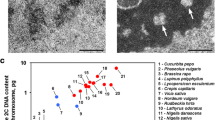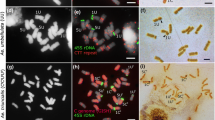Summary
Allium sativum L. (2 n=16) had three types of clones with regard to the number of chromosomes carrying well-defined secondary constrictions: the first type had two secondary constricted chromosomes (type I), the second had three (type II) and the third had four (type III). Silver staining was applied to these three types of cells to determine the number of nucleolus organizing regions (NORs) per cell and to study the relationship between the morphological appearance of the secondary constrictions and the ability of the chromosomes to form nucleoli. Ag-positive regions appeared on two chromosomes in type I, on three in type II and on four in type III. The comparison of Giemsa and Feulgen stained chromosomes with the silver stained ones clearly indicated that the positive reaction with silver occurred exclusively on the secondary constricted regions that responded negatively to both Giemsa and Feulgen staining, indicating that the size of the achromatic secondary constrictions directly reflects the volume of the Ag-positive materials. However, all three types of clones had a maximum of four nucleoli at interphase. Of the four nucleoli, either two or one was extremely small (less than 1 μm in diameter) in types I and II respectively. The size variations of the other nucleoli seemed to be positively correlated with those of the Ag-positive regions. This and the observation that the maximum number of nucleoli per cell did not coincide with the number of Ag-positive regions on the metaphase chromosome complement suggest strongly that the NORs responsible for the minute nucleoli cannot be detected on the metaphase chromosomes. The present observations indicate that not all NORs are indicated by the morphological appearance of secondary constrictions.
Similar content being viewed by others
References
Denton, T. E., Howell, W. M., Barrett, J. V., 1976: Human nucleolar organizer chromo-somes: satellite associations. Chromosoma (Berl.)55, 81–84.
Elsevier, S. M., Ruddle, F. H., 1975: Location of genes coding for 18 s and 28 s ribosomal RNA within the genome ofMus musculus. Chromosoma (Berl.)52, 219–228.
Goodpasture, C., Bloom, S. E., 1975: Visualization of nucleolar organizer regions in mammalian chromosomes using silver staining. Chromosoma (Berl.)53, 37–50.
Hizume, M.,Sato, S.,Tanaka, A., 1980: A highly reproducible method of nucleolus organizing regions staining in plants. Stain Technol.55 (in press).
Howell, W. M., 1977: Visualization of ribosomal gene activity: Silver stains proteins associated with rRNA transcribed from oocyte chromosomes. Chromosoma (Berl.)62, 361–367.
Konvička, O., Levan, A., 1972: Chromosome studies inAllium sativum. Hereditas72, 129–148.
Miller, L., Brown, D. D., 1969: Variation in the activity of nucleolar organizers and their ribosomal gene content. Chromosoma (Berl.)28, 430–444.
Nicoloff, H., Anatassova-Kristeva, M., Künzel, G., Rieger, R., 1977: The behavior of nucleolus organizers and their ribosomal gene content. Chromosoma (Berl.)62, 103–109.
Sato, D., Asano, A., 1951: Basikaryotype analysis inNothoscordum fragrans (2 n=19). Bot. Mag. Tokyo64, 209–215.
Schmid, M., Hofgärtner, F. J., Zenses, M. T., Engel, W., 1977: Evidence for postmeiotic expression of ribosomal RNA genes during male gametogenesis. Hum. Genet.38, 279–284.
Schwarzacher, H. G., Mikelsaar, A.-V., Schnedl, W., 1980: The nature of Ag-staining of nucleolus organizer regions. Cytogenet. Cell Genet.20, 24–39.
Tantravahi, R., Miller, D. A., Dev, V. G., Miller, O. J., 1976: Retention of nucleolus organizer regions in chromosomes of human, chimpanzee, orangutan, and gorilla, Chromosoma (Berl.)56, 15–27.
Verma, S. C., Mittal, R. K., 1978: Chromosome variation in the common garlic,Allium sativum L. Cytologia43, 383–396.
Author information
Authors and Affiliations
Rights and permissions
About this article
Cite this article
Sato, S., Hizume, M. & Kawamura, S. Relationship between secondary constrictions and nucleolus organizing regions inAllium sativum chromosomes. Protoplasma 105, 77–85 (1980). https://doi.org/10.1007/BF01279851
Received:
Accepted:
Issue Date:
DOI: https://doi.org/10.1007/BF01279851




